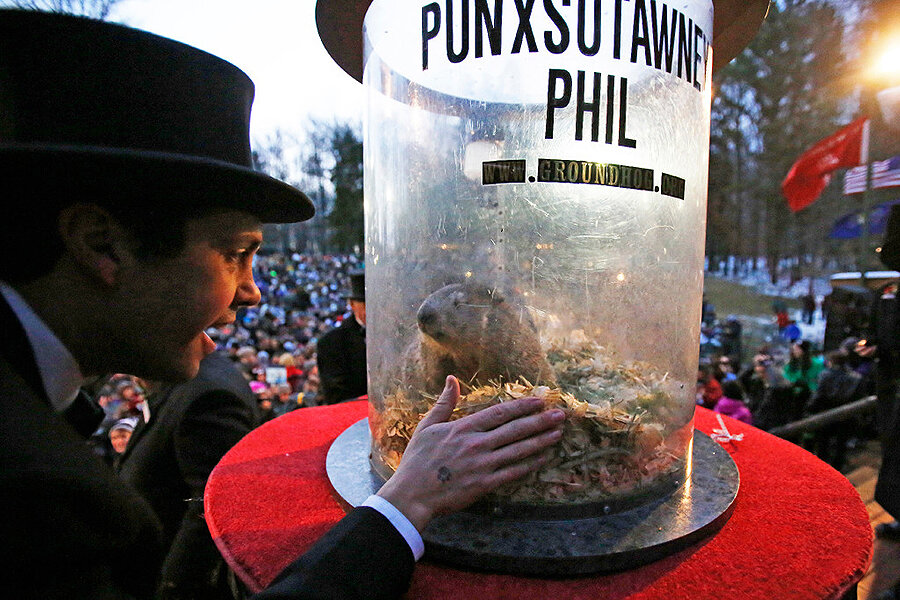Who proclaimed the humble groundhog the 'seer of seers,' anyway?
Loading...
This morning, “seer of seers” saw his shadow after emerging from his burrow. According to tradition, the groundhog’s finding portends six more weeks of winter.
If you believe the Punxsutawney Groundhog Club, the same rodent has been accurately predicting the weather every Feb. 2 since 1887, kept young by a secret “elixir of life.”
Phil has always faced competition from other groundhogs, from North Carolina's Sir Walter Wally to West Virginia's French Creek Freddie. (Although few have as awe-inspiring of a title: Pennsylvania's rodent is formally known as the "Seer of Seers, Sage of Sages, Prognosticator of Prognosticators, and Weather Prophet Extraordinary.") Recent years have brought a fresh threat to his credibility: scientists questioning his reliability. But every Feb. 2, he still manages to draw national attention to a remote clearing in western Pennsylvania.
Thursday’s festivities at Gobbler’s Knob put an American twist on the early Christian mid-winter festival of Candlemas Day, according to Stam Zervanos, a professor emeritus of biology at Pennsylvania State University:
In northern Europe, farmers needed some indication when to start spring planting. They looked for the emergence of hibernators, such as the hedgehog or badger, to signal the coming of spring. Since their emergence occurred in early February, it was believed that if Candlemas Day was sunny, and the hibernator saw its shadow, more wintry weather was ahead. But if it rained or snowed on Candlemas Day, the rest of the winter would be mild.
In the late 19th Century, German immigrants brought this belief to Pennsylvania. They substituted the Keystone State’s groundhogs for the badgers and hedgehogs of their homeland, and a new tradition was born.
The groundhog’s internal rhythms make it well-suited for an early-February forecast. Marmota monax hibernates from about November to March, but it doesn’t take one continuous nap. Instead, its energy spikes an average of fifteen times over the course of the winter, cycling in and out of a torpor, according to a 2013 study.
During one of these brief wake-ups, in early February, the groundhog scopes out prospective suitors, before mating in March. That romantic prelude lined up perfectly with farmers’ need for a weather forecast.
But even if Phil's schedule has biologists’ seal of approval, meteorologists are not impressed. A table on the National Oceanic and Atmospheric Administration website compares Phil’s predictions to the February-March temperature records of every year since 1988. “The table shows no predictive skill for the groundhog,” it concludes. Focusing just on Phil's predictions for February gives him a 46 percent accuracy rate, as USA Today reported.
That so-so record invites competition. Another groundhog, Staten Island Chuck, has made reliable forecasts 80 percent of the time since the Staten Island Zoo began seeking his services in 1981 – or so his keepers say.
But those results have come at a cost. The groundhog used for the 2014 celebration died one week after being dropped by Mayor Bill de Blasio; 2009’s Chuck bit then-Mayor Michael Bloomberg, who cursed at the animal while pulling him out with a plunger in 2011.
Accurate or not, Phil remains on better terms with his handlers and admirers in Punxsutawney.
As a recent post on the Groundhog Club’s “From the Burrow” blog acknowledged, “It is hard to explain the rationale for putting on an event like Groundhog Day let alone the year-long activities and work that support and promote the legend of Punxsutawney Phil.”
But it isn't just fondness for Phil that makes the town keep up the tradition, the blog says, admitting "there is no personal benefit except for a brief moment of notoriety which is mostly local."
"So what gives?" the blog continues. "We put on a party in the middle of winter to give us all a respite from the tedium of winter and maybe a little break for the weight of what we see in the news."
"Most of all understand we are doing this for you and please have a great time," concludes the writer, signed "Phil's Shadow."








